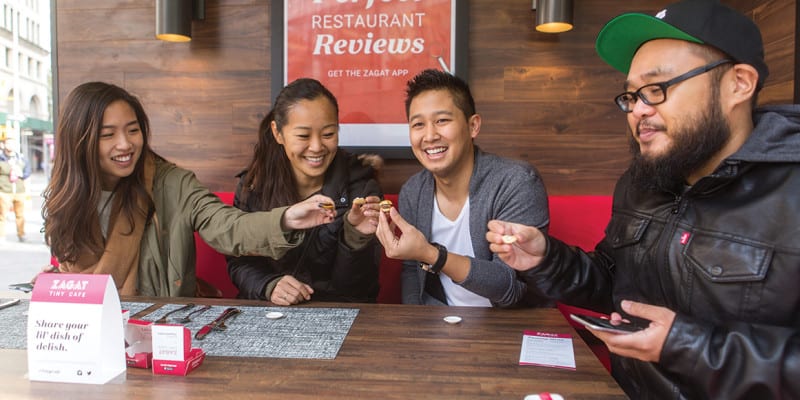Zagat Taps the ‘Tiny Food’ Trend to Draw Millennials

When it comes to picking a restaurant for a night out with friends, most millennials won’t make a move without consulting a restaurant review site. For Zagat, the 38-year-old publisher of restaurant guidebooks, this presented both a challenge and an opportunity that was ultimately solved through a clever pop-up experience that connected its concise reviews to a “tiny food” trend millennials love.
Among many Gen Y consumers, Zagat’s little maroon guides were perceived as outdated—something that their parents consulted for a night out in the city. They had no idea that Zagat was the first to publish reviews from everyday people instead of professional restaurant critics, and that the books offered fewer, more succinct reviews than their online counterparts.
The brand developed a strategy for changing this perception by seizing on a key insight they called “restaurant review exhaustion”—that while millennials love their review site apps, they are also easily frustrated by the time required to comb through all the conflicting opinions. Zagat set out to ameliorate that pain point and differentiate its brand by offering its signature short summaries of user reviews, all available through a new mobile app. The plan was to show millennials that Zagat was a tool for their generation, and that it could deliver all of the opinions they wanted, in way less time.
To draw attention to Zagat’s “tiny-yet-perfect” reviews, the brand aligned itself with the international tiny food trend, a movement made popular on YouTube and across social media with millennials. The Tiny Food Café activation, “proving that small reviews are easier to digest,” opened for three days in October in New York City. It featured a fully functional tiny cafe where customers could order real miniature versions of the city’s best food (for free), prepared with real recipes of some of the most popular dishes at New York City’s highly-rated Zagat restaurants.
From a tiny food gallery and tiny branded takeaway boxes to miniature menus, the activation was designed for social sharing. At a table on the opposite end of the café set with miniature place settings, customers could photograph their tiny food in relation to normal place settings. Visitors were encouraged to use the campaign hashtag #tinycafe. To build momentum before the event, Zagat reached out to foodie influencers, traditional press and social media influencers. Volunteer restaurants and chefs created the tiny food and helped generate buzz around the experience.
By the time the last tiny burger had been served and Instagrammed, The Tiny Café had earned more than one billion impressions, with not a single dollar spent on paid media or influencers. Best of all, Zagat’s “tiny-yet-perfect” reviews were frequently mentioned in the press and on social media, creating authentic connections between the millennial-friendly experience and the fresh new face of the brand.


